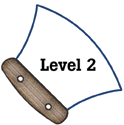
Alaska Science
Key Element D3
A student who meets the content standard should recommend solutions to everyday problems by applying scientific knowledge and skills.
 |
Alaska Science A student who meets the content standard should recommend solutions to everyday problems by applying scientific knowledge and skills. |
|
Performance Standard Level 2, Ages 8–10
|
|
|
|
Sample Assessment Ideas
|
|
|
Expanded Sample Assessment Idea
|
|
Procedure Students will:
Reflection and Revision
|
Levels of Performance |
||
|
Stage 4 |
Student work is complete, correct, appropriate, and shows evidence of elaboration, extension, higher-order thinking skills, and relevant knowledge. Student actively participates in the dissection and cleaning of a wood-burning stove. Student accurately reports the location and characteristics of the residue, identifies the “best” methods to prevent and clean out the residue; and uses evidence to support their methods. | ||
|
Stage 3
|
Student work is complete and but may show limited evidence of elaboration and extension or may contain minor misconceptions or inaccuracies. Student participates in the dissection and cleaning of a wood-burning stove. Student reports the location and characteristics of the residue and identifies a method to prevent or clean out the residue. | ||
|
Stage 2
|
Student work may be incomplete or inappropriate and may show evidence of misconceptions and inaccuracies. Student may be a reluctant participant in the dissection and cleaning of a wood-burning stove. Student report on the residue left by the burning wood may lack detail or contain errors. | ||
|
Stage 1
|
Student work is incomplete, inappropriate or inaccurate. Student may not participate in the dissection or cleaning of a wood-burning stove. Student report lacks detail and contain errors. | ||
Standards Cross-References
|
||
|
National Science Education Standards Identify appropriate problems for technological design. Students should develop their abilities by identifying a specified need, considering its various aspects, and talking to potential users or beneficiaries. They should appreciate that for some needs, the cultural backgrounds and beliefs of different groups can affect the criteria for a suitable product. (Page 165) Design a solution or product. Students should make and compare different proposals in the light of the criteria they have selected. They must consider constraints such as cost, time, trade-offs, and materials needed and communicate ideas with drawings and simple models. (Page 165) |
Benchmarks There is no perfect design. Designs that are best in one respect (safety or ease of use, for example) may be inferior to other ways (cost or appearance). Usually some features must be sacrificed to get others. How such trade-offs are received depends upon which features are emphasized and which are down-played. (Page 49) The solution to one problem may create other problems. (Page 50) Scientific laws, engineering principles, properties of materials, and construction techniques must be taken into account in designing engineering solutions to problems. Other factors, such as cost, safety, appearance, environmental impact, and what will happen if the solution fails also must be considered. (Page 55) |
|
Table of Contents | Return to Alaska Native Knowledge Network